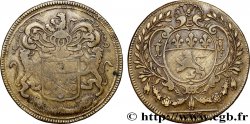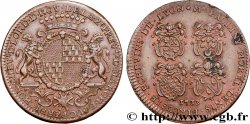fjt_078828 - LYONNAIS - CONSULATE OF LYON Jeton Lt 30, Claude Cachet 1670
Not available.
Item sold on our e-shop
Price : 90.00 €
Item sold on our e-shop
Price : 90.00 €
Type : Jeton Lt 30, Claude Cachet
Date: 1670
Metal : brass
Diameter : 30 mm
Orientation dies : 6 h.
Weight : 7,63 g.
Edge : lisse
Rarity : R1
Coments on the condition:
Usure régulière mais un bel exemplaire
Catalogue references :
Obverse
Obverse legend : * CL. CACHET. ESC. SEIGR. DE. MONTESAN. PRER. ESCHEVIN. DE. L..
Obverse description : Écu aux armes de Claude Cachet, timbré d’un casque taré de face, orné de lambrequins et ayant pour cimier quatre plumes en éventail.
Reverse
Reverse legend : NEC. MORAS. NEC - NOVIT. ERRORES.
Reverse description : Horloge placée sur une table ornée d’un tapis ; à l’exergue : 1670.
Reverse translation : (Elle n'a connu ni les retards ni les erreurs).
Commentary
Exceptionnelle représentation d’une horloge au XVIIe siècle sur laquelle on distingue les heures en chiffres romains. Claude Cachet porte de gueules à trois pals d’or chargés chacun d’un losange de sable en chef.








 Report a mistake
Report a mistake Print the page
Print the page Share my selection
Share my selection Ask a question
Ask a question Consign / sell
Consign / sell
 Full data
Full data



